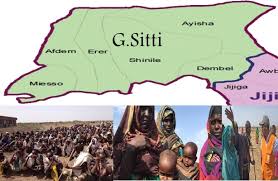 THE DEVIL BEHIND ISSA AND AFAR CONFLICT
THE DEVIL BEHIND ISSA AND AFAR CONFLICT
The conflict between the Afar and Issa communities in Ethiopia is a tragic one that has a long history dating back to their natural state of brotherhood and cohabitation. Over the years, this relationship has evolved from one of cooperation to one of hostile competition for resources such as water and grazing land. The disputes between the two groups have escalated from skirmishes to armed confrontations, resulting in isolated incidents of looting and death. This has ultimately led to constant full-scale war, hatred, and geographic separation between the two communities.
European travelers and explorers have documented stories of the Afar and Issa communities living in harmony in areas even beyond Tadjora, where they would trade together in markets such as Saila. There are accounts of the two groups forming a solid community in Awssa and along the sides of the valley of the Hawash River from Matahara to Lake Abbe. However, the exact reasons for the separation of these communities are unclear. It is known that the present population in the zone of Gawani to Awssa consists of a mixed community of Afar and assimilated Issas who have adopted Afar culture and language. They were both citizens of Haraque tegional adminidtration during Haile Selase and the Derg rules.
The conflict between the Afar and Issa communities has been exacerbated by the influence of modernity and politicized by successive governments in Ethiopia. The Derg regime, followed by the Tigray-led Meles regime, and more recently, the Oromo government of Abiye have all used the conflict for political and strategic purposes. For example, the Abiye government has used the conflict to advance Oromo expansion into the area with ultimate intention to progress towards the sea.
Despite the long-standing conflict between the two communities, it seems that the Afar and Issa people are not fully conscious of the underlying issues fueling the conflict. They do not seem to understand that, Ethiopian government, taking sides with one party only perpetuates the conflict and ultimately weakens both communities. The aim of Ethiopia, as external actors may be to exhaust and disempower the belligerents to the point of disintegration, allowing the Oromo a smooth territorial replacement.There is no doubt that Abiye and his Army was a complice and have consented to the recent devastating set back of the Afar troupes and when they retreated to the corridor linking Djibouti and Addis the government of Addis Ababa and its army turned to label the Issa and all Somalis as terrorists and Al shabab intuders from all Somali corners. The move is surely seved as an alibi to commit genocide and expel Issa and the majority of Ethiopian Somalis from targeted fertile and strategic zones and pave the way for Oromo farmer settlement. This factor serves as a more reason for the now belligerant sides to solve their differences and unite for their survival and for the welbeing of posterity. All bodies and organisations caring and concerned of humanity and humaniterian issues must be invited to be alerted and tuned.
In order to end the conflict and improve the lives of both communities, the Afar and Issa Somali communities must come together, independent from government, to address their differences. They must prioritize peace and cooperation over continued violence and exploitation. By working together to resolve their disputes, both communities can benefit and prosper, rather than being used as pawns in the political games of others.
In conclusion, the conflict between the Afar and Issa communities in Ethiopia is a tragic and complex issue that has deep historical roots. It is crucial for both communities to recognize the harm that the conflict has caused and take steps towards reconciliation and peaceful coexistence. By addressing their differences and working towards mutual understanding, the Afar and Issa communities can create a better future for themselves and their descendants. The responsibility of community leadership is engaged with immediate effect.




